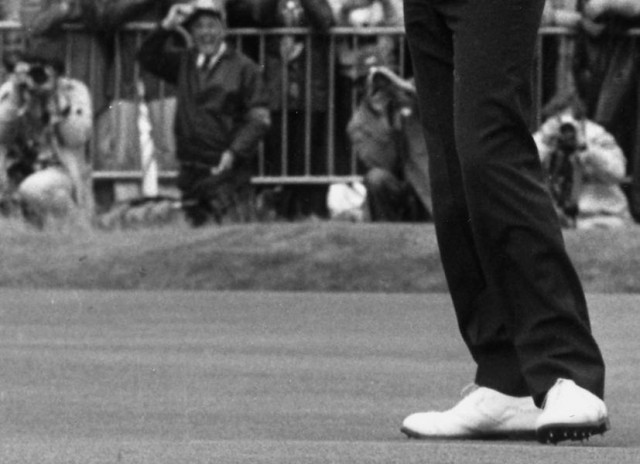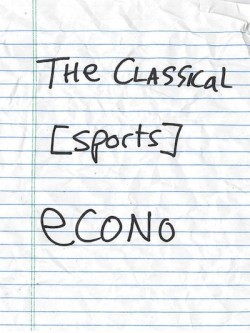We Golf Econo
by Alex Hagen

I.
Golf does not immediately reveal its econo aspect, particularly to the uninitiated. At first glance, it appears anti-econo, a game of privilege and exclusivity, intent on performing and re-performing its superiority and the artifice of its traditions. This, at least, is true at the upper levels of the game’s ruling class, where sponsorship decisions are made and the checks come with seven or eight zeroes. Self-seriousness in golf is not so much an affect as the engine of what goes on. Jim Nantz talking about the azaleas in April, with faux profundity and a gallery full of graying white men with hairless vertically-dominant calves that somehow still taper down to docksiders or white-socked sandals. The Golf Dons treat the official rules as a fetish, and old-style corporate America seems intent on preserving the game as a last bastion of establishment normalcy.

This essay appears in issue #6 of The Classical Magazine, which is called “Econo.” Twenty-six poems, memoirs, histories, fantasies, fictions, non-fictions, prayers, confessions roughly related to sports are inside the latest number of the mag, all to demonstrate that length and depth are different things. Authors include Emma Carmichael, Edith Zimmerman, David Roth, Reeves Wiedeman and Tomas Rios.
As always, you can subscribe to or cop individual issues of the Classical via the awesome 29th Street-powered app for Apple iOS. If you’re not on iOS, you can subscribe — in PDF, Kindle, or ePub formats — through the online store, powered by Space Box.
Golf has “barrier to entry” problems, in figurative and real ways. The game requires large tracts of land that are expensively maintained and often privately held. Its insular world tends to be divided into the entitled Members and the subservient Staff. It takes forever to play, and it thereby self-selects from those who have large swaths of free time on their hands.
Golf is a localized example of the ways in which We Americans splinter up into groups — public/private being a key example — and also how even our recreational activities divide along class and racial lines in deep, consistent ways. We Americans don’t like to talk much about that, in part for lack of a vocabulary. Golf’s ambassadors to the larger non-golf world tend to be too straight-laced and tight-lipped to even skim the surface of any of this. This reticence extends to Tiger, whose impatience with impertinent questions about race and social issues was drilled into his core even before his sexual exploits came to light.
But golf is not monolithic in its meanings. The game played at the local muni is often far removed from the concerns of the USGA or the PGA of America. And, in the past at least, many pros learned to play as caddies and crossed over the social divide, and up the socio-economic ladder, based on the merits of their game. Golf has intrinsic value, and additional value in presenting hypocrisies to be skewered and petards to be hoisted. Without golf, there would be no Caddyshack. Its econo moments stand out more when set against the prevailing, staid warp and woof of the game.
II.
Seve Ballesteros was the most econo golfer of his era, which came after the Watson-Nicklaus duel at Turnberry and ended sometime during the elder Bush’s presidency. Seve’s image sometimes overshadowed his substance, to his irritation. He was almost uniformly referred to as “the swashbuckling Spaniard,” but he had a well-developed game and fiercer intensity. At times, he was elegant and powerful (high draws, towering long irons) but he could also devolve into an erratic, but inventive, recovery artist. He spent entire holes in the woods, only to spare par via some magical approach shot, usually beneath one tree or around another, sometimes having driven onto a green on an adjacent hole or, in one instance at the British — from a parking lot. Bubba Watson’s snap-hooking wedge from the trees in the 2012 Masters resuscitated that Seve magic; that was probably the second most incredible shot at Augusta — after Tiger’s slow-motion chip-in at 16 — that this writer can remember.
Seve’s magisterial feel for the recovery shot sometimes transformed him into a bit of a caricature in the media, who deemed him a beneficiary of luck, rather than a manufacturer of art. Seve won the Masters in 1980 and 1983, finished third in 1982, and second in 1985. In 1986 he chunked a four-iron at 15, SPLASH! (with some murmurings by the crowd that sounded suspiciously like muted cheering), and the Golden Bear went on to win. In 1987, Seve missed a putt on the first sudden-death playoff hole with Mize and Norman, which Mize went on to win by chipping in on 11 and then doing a White-Guy-Golfer celebration. Seve’s failures were less epic than Norman in 1996 and less befuddling than De Vicenzo in 1968. My favorite Seve story is of the potentially apocryphal variety:
Hey Seve, can you tell us about the four-putt on 16?
I miss, I miss, I miss, I make.
III.
Notah Begay comes later, in the Tiger era; he even played with Tiger at Stanford. Notah is pear-shaped and smooth-voiced, an American Indian Other tramping around the green fairways. On tour, Notah used a gold-hued putter that was flat on both sides.
For putts of less than fifteen feet, he would putt right-handed or left-handed depending on the break. This is now known as switch-putting.
Switch-putting is anomalous and beautiful. Being ambidextrous is a form of shape-shifting, adapting the means employed to the situation at hand. Notah is now a commentator, trafficking in the golf-whisper with as much diplomatic aplomb as David Feherty. Neither were particularly strong players; both are superb commentators. This reflects the Wallacian insight about how athletic execution and self-consciousness are at war with another. Notah’s past struggles include a pair of DUIs, which he appears thankfully to have put behind him, whereas Feherty’s struggles are looming and omnipresent and grist for his mytho-poetic mill.
IV.
The most econo golfer in the world today is not a golfer, or at least no longer a professional golfer. David Feherty is more of an apostate than an ambassador; most in the golfing world love him all the more for it. He pops pills, battles demons, and provides coherence, comic relief, and luminous insight to the narrative of a final round. Golf depends on television to deliver its product — going to a tournament and watching it live denies you the simultaneity of competition, whereas the couch-sitting TV watcher has a certain omniscience in knowing how the field sits before most of the individual players do. Feherty is lively, talkative, and uncensored — an orientation at odds with the run-of-the-mill Tour player.
Faherty serves as the MC of a telecast and, of late, an eponymous television show. He rejects cant and seems intent on enlivening the tournament telecasts with equal parts humor and humanity. He sometimes pushes too far to get a laugh, but like Blake said, you’ll never know what is enough until you know what is too much. His honesty is piercing and a welcome relief from the mumbling inanities that most of the players seem content to offer.
Feherty once confessed to shitting his pants late in a round in a tournament on what he deemed the Safari Tour. He had his caddy pull out his rain pants, and he finished the round. Sometimes what’s on the scorecard matters less than that you finished the round, with fuck-all concern for looking respectable or appropriate in the process. Presumably finishing the round was for Feherty the moral victory on the pants-shitting day. Our victory comes from the fact that he is unafraid to tell the tale and unafraid at the prospect that we might think less of him for having heard it told. In golf, it is said that there are no pictures on the scorecard — that the number, not the way in which it was achieved (the style), is what matters. And that is a charismatic anti-style unto itself. Call it econo.
Alex Hagen lives in Sioux Falls, South Dakota, with his wife Blayne. He plays golf sporadically.
